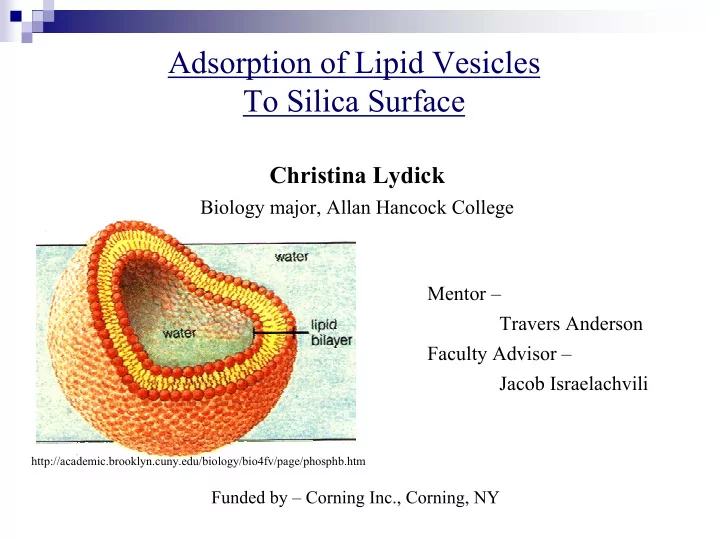

Adsorption of Lipid Vesicles To Silica Surface Christina Lydick Biology major, Allan Hancock College Mentor – Travers Anderson Faculty Advisor – Jacob Israelachvili http://academic.brooklyn.cuny.edu/biology/bio4fv/page/phosphb.htm Funded by – Corning Inc., Corning, NY
Lipid Vesicles On Silica Lipid vesicles adsorb… 50 nm ...then rupture… …creating bilayers supported on a substrate. Schonherr, H., et al. Langmuir, 20 , 11600-11606 (2004)
Supported Lipid Bilayers Applications and uses: • Cell membrane models • To better understand actual cell membranes • Biosensors • Portable, inexpensive devices to test for diseases in remote areas
Creating Vesicles •Lipids come in vials in chloroform •Evaporate chloroform while rolling vial to create bilayer sheets •Add buffered solution to vial •Freeze/thaw to break sheets into vesicles •Pass vesicle solution through extruder to break down vesicles to 50 nm. http://academic.brooklyn.cuny.edu/biology/bio4fv/page/phosphb.htm http://img.sparknotes.com/figures/A/a981208a1abd542364d5a13c08702881/phospholipid.gif
Adsorption Kinetics of Vesicles to Glass Surfaces � Rate at which vesicles adsorb � Variables that affect this process � Vesicle concentration � Salt concentration � Temperature � pH Quartz Crystal Microbalance (QCM)
Quartz Crystal Microbalance (QCM) How it Works • Quartz crystal vibrates as vesicles adsorb and then rupture • QCM measures the frequency of the vibrations • QCM measures the decay of oscillations of the quartz crystal Schonherr, H., et al. Langmuir, 20 , 11600-11606 (2004)
Analyzing Results Sauerbrey Equation ∆ m = -C ∆ f n ∆ m, adsorbed mass C, constant = 17.7 ng/Hz cm 2 ∆ f, frequency change n, overtone number = 3 (Depends on the resonant frequency being measured at) Temp: pH: Solution: Experimental conditions: 30°C 7.4 PBS, 150 mM NaCl
Analyzing Results
What Remains to be Done Continue running experiments with the QCM to determine the best adsorption rate of vesicles when in a solution varying in: Temperature: 15 – 40°C pH: 5 – 9 Salt concentration: 0 – 200mM To determine the most efficient conditions to create supported lipid bilayers.
Acknowledgements Travers Anderson, Mentor Jacob Israelachvili group INSET National Science Foundation (NSF) California Nanosystems Institute (CNSI) Corning Inc. Special thanks to : Samantha Freeman Julie Niles, AHC MESA director
Recommend
More recommend